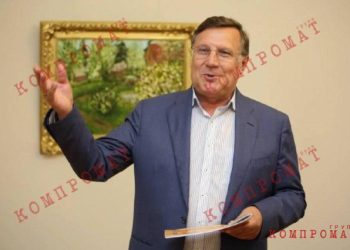© “Stringer”, September 2000
From “Collusion” to “Contagion”
The assertion that Anatoly Chubais is the only liberal and democrat in Russia has already become a commonplace. So common that it has become a public space. Russian journalists, imagining themselves as defenders of liberal ideas, cite Anatoly Borisovich as an unquestioned authority on democratic reforms.
The myth of Chubais’s decency and selflessness is cultivated deliberately. It is based on the supposedly impeccable reputation of Anatoly Borisovich in the West. Meanwhile, abroad there are also stringers who try to stay away from officialdom.
Two books have already been published in the United States telling the true story of privatization: “Collision and Collusion” by Janine Wedel and “Contagion” by Anne Williamson. The title of the first book is translated as “Conspiracy and Conflict,” and the second is “Contagion.”
Both books were a resounding success in the academic community. And if Ms. Wedel was published only in the first edition of 10 thousand copies, then “Contagion” is still distributed in handwritten form. Not a single publishing house in the world wanted to quarrel with the US administration. Below “!” publishes a short excerpt from “Contagion” and an interview with the book’s author, Anne Williamson.
Unpleasant Surprises (excerpt)
From the very beginning, the Harvard team bought into one of the oldest Russian canards: “revolution from above.” They imagined that they would take part in the struggle between the “clean”, members of Chubais’s “St. Petersburg mafia”, and the “unclean” – it seems that everyone else was included in it. Harvarders have widely publicized their belief that a measured mixture of economic changes, a “model change,” would push Russia toward prosperity. But they remembered to themselves: strengthening the political weight of their Moscow protégés costs several billion dollars.
The common misconceptions of both teams about Bolshevik capitalism united them into a group of “Harvardites.” Both sides attested to each other’s good intentions and were tested by the Western media, which went hoarse with toasts in their honor.
As evidence of the incestuous nature of the “Harvardites,” there is a complete collection of their publications on the history of the issue. Now they cannot disown each other, all these books and articles have bound them forever. All we need to be completely happy is one Korean graduate student from a university somewhere in the Midwest to draw a family tree of their efforts. The funny thing is that for the last few years, Shleifer (Andrei Shleifer is an employee of Harvard University, worked at the Privatization Center together with A. Chubais, was urgently recalled from Moscow by the university management due to suspicion of corruption – “!”) did not write about anything other than about corruption in Russia, corruption in Russia, corruption in Russia. He clearly had access to some proprietary information.
To deliver funds exactly to their political clients, the Harvard Institute for International Development used Russian tactics. Just like a nomenklatura boss “privatizing” a ministry or institute, the “Harvardites” created a dummy – the non-governmental foundation “Russian Privatization Center”. A kind of funnel for sponsorship money. According to its head, Maxim Boyko, the Center collected about four billion dollars in Western aid, which, as the Accounts Chamber said, “were misused.”
Everyone gave: USAID (US Government Agency for International Development), TACIS (European Union Program for Technical Cooperation and Development in Eastern Europe and the CIS), the British Know-How Fund (British government Know-How Fund), Germany, Japan, non-governmental organizations. Some, such as the World Bank and the European Bank for Reconstruction and Development, provided loans to these non-existent structures, created as private holdings for Harvard-elected leaders, while the forgotten Russians were left to their own devices.
The staff of the Russian Privatization Center immediately began to improve their financial situation, and USAID admitted that the Center was created to hide the income of government officials. Thus, as the Americans sensibly reasoned, none of the “energetic young reformers” of the Harvard type would be forced to earn a living at their workplace.
Erlenger (a journalist from the New York Times – “!”) describes four young people from Russia, all of whom are dependent on foreign money to one degree or another. Two of them are entrepreneurs, but the description of Elena Shalneva, the daughter of an Izvestia correspondent, is especially funny. She has everything – travel, foreign education, excellent English, she is the press secretary of the Russian Privatization Center. Erlenger rather sloppily describes the Center as an agency “partly financed from abroad” (one hundred percent and very generously). Shalneva herself slanderes her less fortunate compatriots, whose financial difficulties arise entirely through their own fault, being photographed in front of the spiral staircase in her newly renovated Moscow apartment with a cute little fluffy dog, a real dog of a socialite. Only a handful of Russians were able to take advantage of American taxpayers’ money, but whoever got to them was rowing with both hands.
The Russian Privatization Center had neither a work plan, nor a program document, nor anything at all that could somehow record the progress in their endeavors. These spenders did not even think of providing the required information to philanthropists to regulate their work.
A typical paper is the 1994 annual report, which most closely resembles the final document of a high school parent-teacher meeting. Not a single financial figure. The comments are both vacuous and eerily familiar, evocative of the mastery of Soviet lip service.
Professor Wedel reports that all the comments of the Duma and the Accounts Chamber of the Russian Federation regarding the “Russian Privatization Center” were ignored in the same way as the comments of the GAO (US Accounts Chamber – “!”) regarding the list of mercenaries from Harvard in the payroll of the “Russian Privatization Center”.
My own examination of the biennial reports of the Harvard Institute for International Development revealed that its staff are themselves masters of conspiracy, since these reports do not contain any useful information about the sources and expenditures of funds that are financed exclusively by US taxpayers.
From Harvard’s point of view, the “Russian Privatization Center” worked so well that the Institute created in 1994-1995 two more quasi-public structures for receiving and distributing foreign grants and loans: the Resource Secretariat (RS) and ILBE, which one of the Moscow wits deciphered as “ The Institute for a Lobby-Based Economy” […] [“Институт изучения экономики, основанной на лоббировании”- прим. Компромат.Ру].
Thus, everyone was satisfied: Maxim Boyko soared high in the “Russian Privatization Center”, Dmitry Vasiliev (former head of the Russian Federal Securities Commission, has recently been sharply criticizing Chubais for Anatoly Borisovich’s desire to restructure RAO UES – “!”), Hay (Jonathon Hay, partner of Kenneth Dart, a billionaire known in the world as a specialist in financial blackmail – “!”) in ILBE, and Chubais was appointed manager of the main privatization operation – GKO.
Left to frolic free with other people’s money, led by no one except Hay, they spent tens of millions on failed projects like a network of regional Privatization Centers, turned into a national political machine for Maxim Boyko, supported by Chubais.
The employees of these centers received salaries for appearing in the offices and did nothing, fearing that the initiative of ordinary people would destroy Chubais’s plans, paid for by the United States. The result of Hay’s efforts aimed at territorial expansion and all-out support for the slaughter-fed dollar was the adoption of only a small part of the nineteen laws that Hay promised to the US Ambassador, Mr. Pickering. And also the dominance of changeable presidential decrees issued in order to circumvent local election legislation.
“Harvardites” were so confident in their right to spend other people’s money and believed in the inexhaustibility of this source to such an extent that Dmitry Vasiliev in 1995 refused a grant offered by Stanford University in order to protect his Harvard benefactors from competition. USAID even offered to cover all of Vasiliev’s expenses until he could secure a World Bank loan for his Federal Security Commission.
The terms of the agreement were very favorable. The list of top-level managers was the same everywhere: Oslund (adviser to the Gaidar government – “!”), Hay, Vasiliev, Chubais, etc. Thus, outwardly everything satisfied the conditions of the West and ensured effective management, but in reality it hid the usual system of cronyism. For example, when Yeltsin first removed Chubais in early 1996, Andrei Shleifer quickly filled the gap.
Shleifer hired the suddenly unemployed Chubais – whose former agency and his very name were the focus of all Harvard Institute enterprises – as a consultant at a salary of $10,000 a month!
Shleifer later explained that Chubais was so quickly hired by the fact that he was deeply touched by the sight of the suddenly fired “tsar of reforms”, forced to be content with smoked sausage sandwiches in cheap eateries at the Davos conference in 1996.







